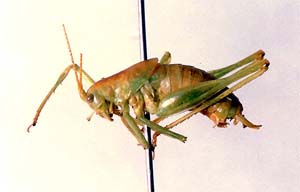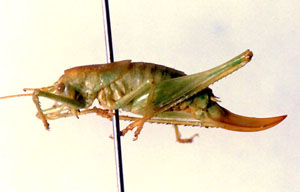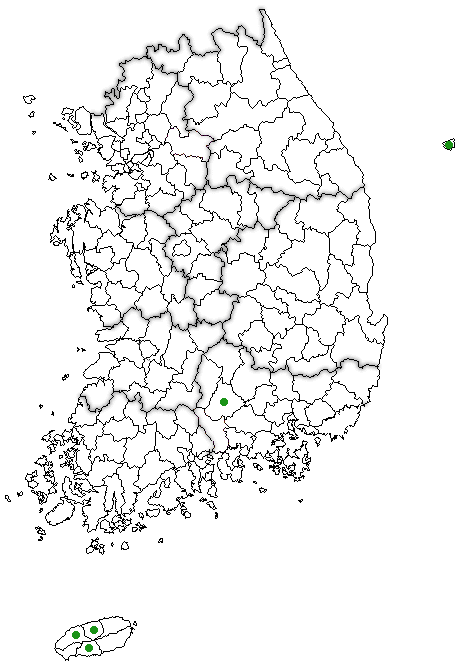민어리쌕새기
Cosmetura fenestrata Yamasaki
1983
몸길이는 약 8-14 ㎜이며 연한 황녹색이다. 머리는 작고 앞가슴등판이 길게 잘 발달하였다. 수컷은 성충이 되어도 날개는 매우 짧아 앞가슴등판 밑에 가려지며 암컷은 날개가 거의 보이지 않는다. 산지의 낮은 풀 위에 모여 산다. 일본에도 분포한다.


수컷
(Male) 암컷
(Female)
Original description:
Cosmetura fenestrata
Yamasaki 1983 Mem. natn. Sci. Mus. Tokyo 16: 137, figs. 9-15.
Very similar to the type-species of
the genus. Grass-green, with a chestnut brown mesal band on the
dorsal surface of body. The pronotal band is narrower than the abdominal
one. Male supra-anal plate as shown in Figs. 13-15, without dorso-mesal
corniform protuberance situated between the triangular latero-basal
plates. Hind tibial teeth smaller in number than those of the type-species
of the genus.
Male. Head and pronotum as shown in
Figs. 1 and 2, almost the same as in the preceding species. Lateral
foramina of thorax (thoracic auditory spiracles) small, but
a little wider than in the preceding species. Fore wings as shown
in Figs. 11 and 12, with degenerated veins; stridulatory vein not
so broad as in Tettigoniopsis forcipicercus;
stridulatory teeth 82 (right fore wing) and 93 (left fore wing)
in number in a specimen examined. Fore and middle legs also almost
the same as in the preceding species, but the auditory structure
of fore tibiae is long and wide elliptical. Hind legs with 18 to
24 teeth on both the dorsal margins of tibiae.
Abdominal
end as shown in Figs. 13-15. The tenth abdominal tergite becoming
wider ventro-laterally and roundly protruded ventro-posteriorly.
The tenth abdominal tergite depressed between the cerci. Supra-anal
plate similar in shape to that of the type-species, but it is different
in the absence of dorso-mesal corniform protuberance on the dorsum
in anterior half; this part becoming a concavity and making a pale
fenestra; a ventro-medial protuberance at the subbasal portion wide
at base, then narrowing, flat at apex, depressed antero-posteriorly;
posterior half becoming wider, posterior angles round and posterior
margin incised or incurved at the centre. Cerci also similar to
those of the type-species, gently incurved at the apical half, with
a thin triangular inner protrusion at the dorso-subbasal portion.
Subgenital plate wide, becoming narrower and curled dorsally
in apical third; posterior margin incurved at the inner side of
styli, and roundly but weakly protruded between the incurved parts.
Coloration.
Almost the same as in the preceding species, but there are some
differences. The longitudinal brown band is narrower on occiput
and pronotum than on the dorsum of abdomen. Lower genual lobes of
each femur black in apical half.
Measurements (㎜).
Body length from apex of fastigial cone to apex of cercus, 12.0-12.8
(12.0 in holotype); head width (extraocular distance), 2.2-2.3 (2.2);
pronotal length, 4.7-4.8 (4.7); fore wing length, 2.4-2.8 (2.8);
hind femoral length, 8.6-8.7 (8.7); hind tibial length, 9.5 (9.5);
cerci length, 2.1-2.2 (2.2).
Female. Unknown.
Type
material. Holotype: ♂, eastern slope of Mt. Funagata-yama, 900
m, Masuzawa, Taiwa-cho, Kurokawa-gun, Miyagi, 8. ix. 1982 (T. Yamasaki).
Other
material examined. 1♂ (in alcohol), same data as the holotype.
Type-locality.
Mt. Funagata-yama, Ou Mountain Range, Tohoku District, Honshu, Japan.
Notes.
This species is closely related to the preceding species, but is
different in the shape of male supra-anal plate and the number of
teeth on the dorsal margins of hind tibiae. This species lives on
the leaves of broadleaved trees in the mountainous forest and occurs
sympatrically with Tettigoniopsis forcipicercus
Yamasaki at the collecting sites on Mt. Funagata-yama, Ou Mountain
Range. The specific name 'fenestrata'
is derived from the presence of a pale fenestral concavity instead
of a dorso-mesal protuberance in the anterior half of male supra-anal
plate.

<참고문헌>
● Kim TW and
Kim JI 2001. A taxonomic study on four subfamilies of Tettigoniidae (Orthoptera:
Ensifera) in Korea. Korean J. Entomol. 31(3): 157-164.